In my recent post about Asters and Campanulas, I named my aster as A. divaricartus. I have since found its label and it is in fact A. latifolius ‘Lady in Black’
Author: The gardener
Pond project
I have embarked on a rather major project, and just hope that I won’t have bitten off more than I can chew. The garden needs a pond, to meet the following main requirements:
- maximum wildlife benefit
- not too small
- not necessarily with running water as such
- maintained as far as possible without tap water (note to self: explore whether water could be pumped into the pond from the nearby well)
- deep enough in at least part to provide safety for frogs through the winter
- as natural looking as possible, without copings, and with graduated slopes/beaches for easy bird access
- partly surrounded by bog
 The first two pictures are of my front garden. It has several gaps, which are going to be needed shortly. There’s a new Amelanchier lamarckii in there which I planted a couple of months ago, some Sweet Williams, a few small perennials, many bulbs, and a little group of hollyhocks.
The first two pictures are of my front garden. It has several gaps, which are going to be needed shortly. There’s a new Amelanchier lamarckii in there which I planted a couple of months ago, some Sweet Williams, a few small perennials, many bulbs, and a little group of hollyhocks.

Then we have the pond area itself. I cleared it of plants a while ago and saved those that seemed worthwhile. Several roses were in bad shape and had to go. The tree trunk belongs to Betula jacquemontii, around which I hope to grow the Pieris that I saw at Fursdon. The hostas currently there will move to the side and will form the edging for the pond.
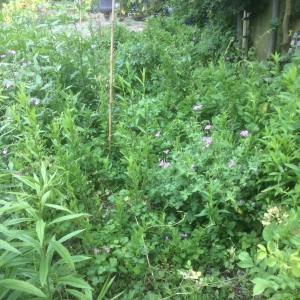 The somewhere is shown in the next two pictures, which show a bed which has not yet been properly formed, although it contains a number of plants, many of them worth keeping. These plants have got to be moved and saved, partly to the front garden using up all the available space
The somewhere is shown in the next two pictures, which show a bed which has not yet been properly formed, although it contains a number of plants, many of them worth keeping. These plants have got to be moved and saved, partly to the front garden using up all the available space 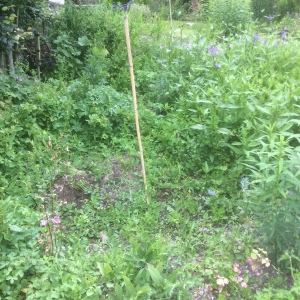 there, and partly to some beds near the back gate where they can be heeled in for the time being. An awful lot of the greenery in these two photographs is bindweed unfortunately, invading the space with the speed of kudzu, fortunately easy to clear if not to eradicate.
there, and partly to some beds near the back gate where they can be heeled in for the time being. An awful lot of the greenery in these two photographs is bindweed unfortunately, invading the space with the speed of kudzu, fortunately easy to clear if not to eradicate.
The reason the plants have to be moved, is that this is where the excavated soil is going to go, to make a new bed in the form of a substantial mound. Before I do too much in the way of excavation, I need to dig a trial hole, to see how much depth of soil there is before I reach the clay. I may have to do the excavation in two stages, one to reserve the topsoil, and two to dig out the clay and put that to the mounded bed first, and then put a layer of topsoil on top.
The work has been done so far by me alone, but mercifully my family are going to help with the digging and carting, so my priority for now is to dig up the bed where the mound will be, so that there will be somewhere to take the excavated soil to.
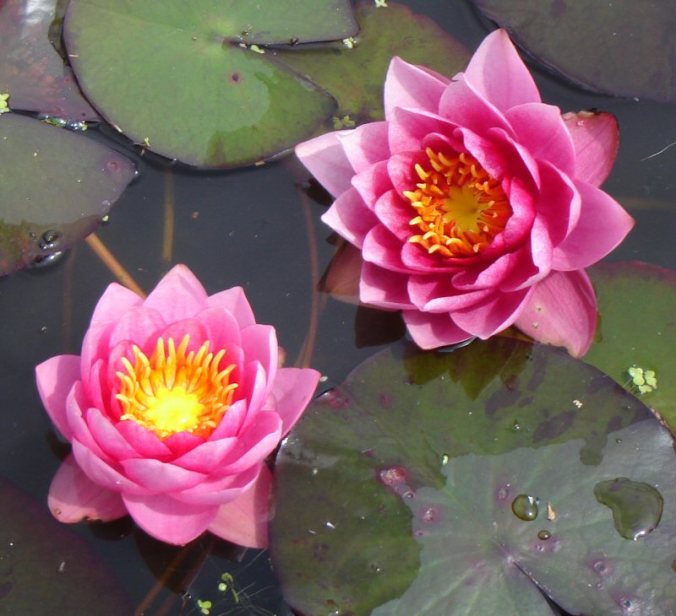 The first plant to go into the pond is to be Nymphaea ‘James Brydon’. Water lilies are said to like full sun, but N. ‘James Brydon’ is known to be tolerant of shade, and certainly the one I had in the pond in Scotland performed really well, in much deeper shade that the pond here is going to enjoy.
The first plant to go into the pond is to be Nymphaea ‘James Brydon’. Water lilies are said to like full sun, but N. ‘James Brydon’ is known to be tolerant of shade, and certainly the one I had in the pond in Scotland performed really well, in much deeper shade that the pond here is going to enjoy.
Aster and Campanula
i am always looking for good plant combinations (like the Lychnis coronaria with Geranium ‘Rozanne’ which I mentioned in the last post), and I think I may have found one.
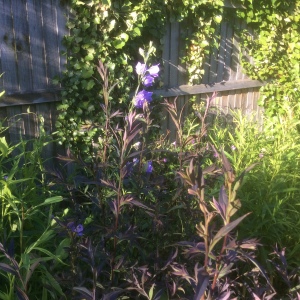 This is Aster laterifolius ‘Lady in Black’ (I found the label), and growing up through it is a Campanula persicifolia, which was not planted or sown by me, but just arrived there (and in several other places in the garden, all as singletons). The result is far from spectacular just yet, but I think it is going to be a success when both plants have become better established and spread a bit.
This is Aster laterifolius ‘Lady in Black’ (I found the label), and growing up through it is a Campanula persicifolia, which was not planted or sown by me, but just arrived there (and in several other places in the garden, all as singletons). The result is far from spectacular just yet, but I think it is going to be a success when both plants have become better established and spread a bit. 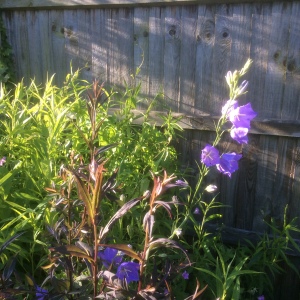 The Aster doesn’t need staking, although a metre high or more, which is a big plus, and has this spectacular bronze/purple leaf and stem colour, topped eventually (after the Campanula has finished), by a lot of fairly small white flowers, dusky pink in the middle
The Aster doesn’t need staking, although a metre high or more, which is a big plus, and has this spectacular bronze/purple leaf and stem colour, topped eventually (after the Campanula has finished), by a lot of fairly small white flowers, dusky pink in the middle
The Aster won’t be ready for division next spring unless it makes a lot more growth than it has so far, but I am keen to increase its presence as quickly as I can. The Campanula I shall cut down the moment it has finished flowering, in hope of a second go in the autumn. I can collect seed from the other campanulas instead.
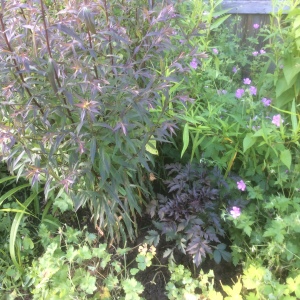
Aster with D. ‘Bishop of Llandaff’ planted alongside
It seems to me that two plants would also combine rather well with the Aster, and these are Verbena bonariensis (which I already have), and my favorite dahlia, D. ‘Bishop of Llandaff” which I bought a couple of days ago and have planted alongside.
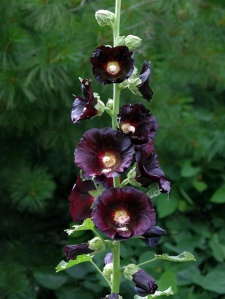 If I can just get one of my grown-from-seed hollyhocks, with practically black flowers, to raise its head behind the whole assemblage, i think the whole thing will be a good look.
If I can just get one of my grown-from-seed hollyhocks, with practically black flowers, to raise its head behind the whole assemblage, i think the whole thing will be a good look.
Rose Campion and its cousins
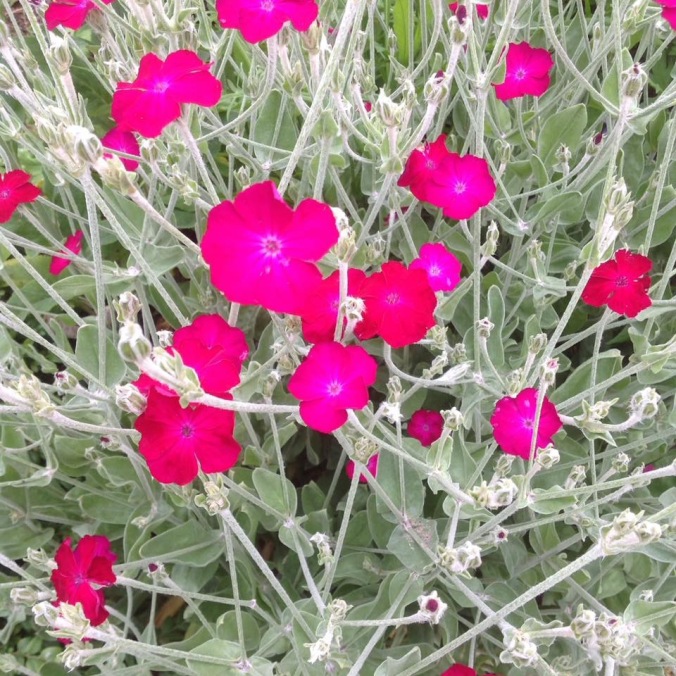
Seeing this gorgeous Lychnis coronaria posted on Facebook by Jane Schofield, prompted me to look into the campion family, about which there is plenty of confusion, because the campions are Lychnis, or Silene: these names are often interchangeable, but not invariably.
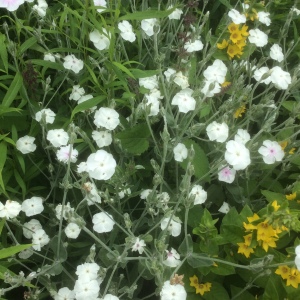
Lychnis coronaria ‘Alba’
Lychnis coronaria (above) is a good starting point, because the RHS declares that it is Rose Campion (it also has the intriguing English name of ‘Bridget-in-her-bravery’ – nobody seems to know where that comes from). The white flowered variety is Lychnis coronaria ‘Alba’ which is indispensable also.
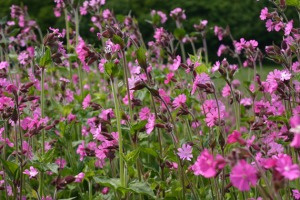
Lychnis dioica (red campion)
These are not to be confused with Lychnis dioica (red campion) which I think is more usually called Silene dioica, and has another synonym which is Melandrium rubra (though I’ve never heard anybody use this). There are named varieties of L. dioica, but none that I’ve seen are an imorovement on the species, carefully selected.
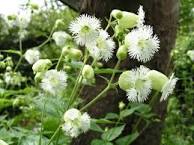
Silene fimbriata
The other campion I know well is Silene fimbriata (always called Silene I think), which is a great performer In an untidy way, in very deep shade.
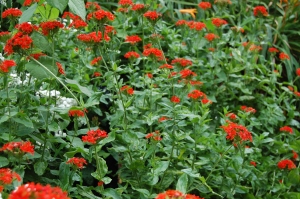
Lychnis chalcedonica
There is one more to mention, which is completely different to the others, namely Lychnis chalcedonica, with brilliant vermillion flowers in compact dome heads, which I should like to try. It has English names given to it, of Maltese Cross and Jerusalem Cross. Gerard’s Herball, in 1597: ‘ THere be divers forts of Rofe Campions, fome of the garden, and others of the field: … and firft of the Campion of Conftantinople Lychnis chalcedonica.‘ He says the Germans call it ‘flower of Ierufalem‘. Part of the reason I like Gerard so much is that he is very keen on the ‘ temperature and vertues‘ of his plants, but in the case of L. chalcedonica he just says ‘befides that grace and beautie which it hath in gardens and garlands‘ (coronaria means garlands incidentally) ‘it is for ought we know of no vfe at all in phificke ; for which caufe the vertues thereof are not yet found out.‘ In other words it’s useless!
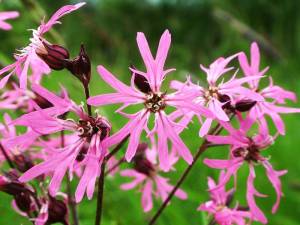
Lychnis flos-cuculi
I forgot to mention Lychnis flos-cuculi, that pretty wild flower (Ragged Robin), which like Red Campion is at home equally in the garden and in the wild.

Lychnis coronaria and Geranium ‘Rozanne’
Finally, here’s a picture of Jane’s delightful combination of Lychnis coronaria with Geranium ‘Rozanne’
Clematis viticella
i think Clematis viticella must be the most useful and versatile climber there can be. At present I have only two trees as such in the garden, the fairly mature Betula jacquemontii (or more properly B. utilis var. jacquemontii) and the disappointing Acer palmatum ‘Red Flamingo’. As it happens I don’t want to grow clematis up either of them, but for the three trees I plan on planting this Autumn, I want to grow C . viticella up each one of them. 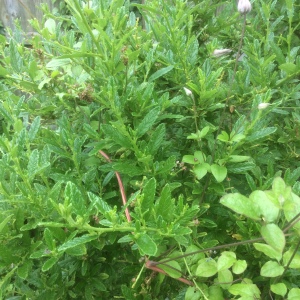 I already have one growing on Ceonothus concha which flowers beautifully but spends the rest of the year looking rather dull, and this is C.v. ‘Purpurea Plena Elegans’, which is about to flower any day now.
I already have one growing on Ceonothus concha which flowers beautifully but spends the rest of the year looking rather dull, and this is C.v. ‘Purpurea Plena Elegans’, which is about to flower any day now.
The three trees are Malus sargentii, Prunus avium ‘Sunburst’ and Pyrus salicifolia ‘Pendula’.
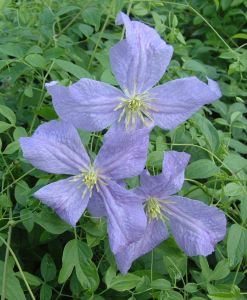
C.v. ‘Emilia Plater’
My favourite is C.v. ‘Emilia Plater’ which is a delicate grey blue, which I think should pair up well with the crab apple.
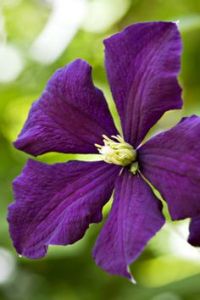
C.v. ‘Victor Hugo’
C.v. ‘Victor Hugo’ is a strong deep violet, and should look stunning scrambling over the silver pear tree,
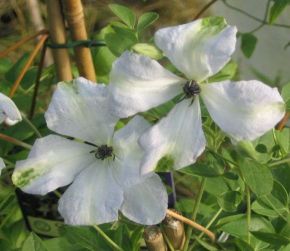
and C.v. ‘Caerulea Luxurians’ with its palest blue/white flowers should suit the cherry very well.
L
As an afterthought, I might well see if I can persuade Tropaeolum speciosum to grow into the Ceonothus: that would brighten it up after it’s over, and no mistake, though it is galling to think that I would have to pay £5 for a plant here, when I could have got 100 plants from my previous garden at no expense at all.
Rosa complicata
One way to help make sure I am not overwhelmed by roses, is to exclude all hybrid tea roses, which I don’t like much because they don’t seem to like going with anything, and which involve too much care. I would rather have climbers and shrub roses, preferably ones I can smell.
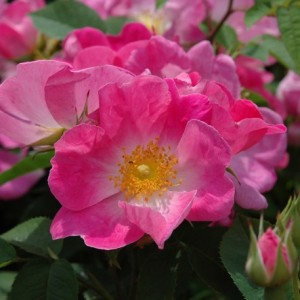 I have dug out a number of very old gnarled hybrid teas from what seems to have been a rose bed once, leaving the lovely R. ‘Fru Dagmar Hastrup’ which I was able to identify because I had one in Scotland. It is now recovering from several years of neglect, and seems very healthy and well set up for next season.
I have dug out a number of very old gnarled hybrid teas from what seems to have been a rose bed once, leaving the lovely R. ‘Fru Dagmar Hastrup’ which I was able to identify because I had one in Scotland. It is now recovering from several years of neglect, and seems very healthy and well set up for next season.
I planted one more shrub rose earlier this year, which is now more or less over, R. ‘Complicata’. It has gallica in its parentage, but has large single flowers and quite a lax habit, so that I can treat it as a shrub rose, and also as a climbing one at the same time. 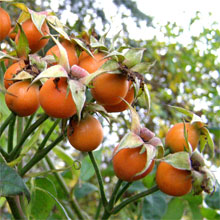 Although it just has a six-week flowering period, it does produce big hips later on. There seems to be quite a lot of variation in the colour, with the centres of the flowers which tend to be a paler pink, and with the intensity of the pink colour overall.
Although it just has a six-week flowering period, it does produce big hips later on. There seems to be quite a lot of variation in the colour, with the centres of the flowers which tend to be a paler pink, and with the intensity of the pink colour overall.
But as roses go it seems very versatile, and should combine well with almost anything.
Geranium to identify
 This geranium is recovering from being thoroughly battered by a huge thunderstorm and deluge. I’m about to cut it back so that it can flower some more in the autumn.
This geranium is recovering from being thoroughly battered by a huge thunderstorm and deluge. I’m about to cut it back so that it can flower some more in the autumn.
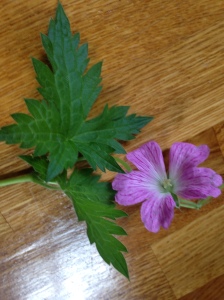 Meanwhile, I wonder if anyone can have a go at identifying it. I know it is not G. x oxonianum, though its flower looks similar. Perhaps it could be G. endressii, which is a parent of G. x oxonianum but has no brown blotches on its leaves.
Meanwhile, I wonder if anyone can have a go at identifying it. I know it is not G. x oxonianum, though its flower looks similar. Perhaps it could be G. endressii, which is a parent of G. x oxonianum but has no brown blotches on its leaves.
Geranium with blue flowers

This is the only geranium in the garden with a blue flower, and I’ve found it difficult to identify, as there are so many varieties. I’ve ruled out the ones that I know best, that is, ‘Buxton’s Variety’, ‘Johnson’s Blue’ and ‘Rozanne’
I think it must be Geranium ‘Skinners’. It is not a very prolific flowerer, but perhaps that’s because it has grown up without help of any kind.
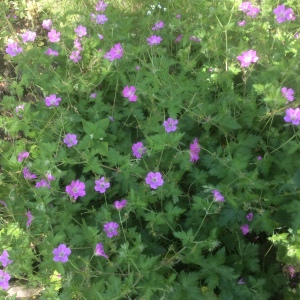 Shoemakers Garden has plenty of pink-flowered Geraniums, which should be identifiable when I can get around to doing that. One of them I know well as G. macrorrhizum ‘Album’, but the others are harderto nail down.
Shoemakers Garden has plenty of pink-flowered Geraniums, which should be identifiable when I can get around to doing that. One of them I know well as G. macrorrhizum ‘Album’, but the others are harderto nail down.
 I am going to try and sort out which the other geraniums are; in the autumn there will be a great many ready for division and disposal, but too many people are in the same boat, so i may have to end up throwing the divisions away, which I hate doing.
I am going to try and sort out which the other geraniums are; in the autumn there will be a great many ready for division and disposal, but too many people are in the same boat, so i may have to end up throwing the divisions away, which I hate doing.
Tanacetum vulgare var. crispum (Fernleaf Tansy)
I posted this photograph a couple of weeks ago, when we were puzzled as to what it was. It’s growing in a bed at Gorsemoor, on Dartmoor, having been acquired unnamed from the excellent little nursery at Illand near Launceston (no website, no catalogue, just an eclectic collection of plants).
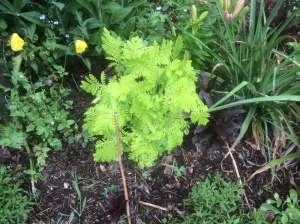
We thought it must be either Tansy or Feverfew, and by now the answer has been found. It is a tansy in fact, but not the usual wild plant. It is Tanacetum vulgare var. crispum.
It has several English names, one of which is Parsley Fern, which is thoroughly misleading for Parsley Fern is actually that tiny Cryptogramma crispa, which is a true fern. Fern leaf Tansy or Curled Tansy seem the most reasonable. Crispum just means ‘curled’
I’ve always thought of tansy as a herb, though never found out what for, let alone experimented with it. Just as well perhaps, because its Latin name translates as Death Plant! Gerard described it as “pleasant in taste” though, and effective against gout. It is disliked by most insects, but favoured by bees and butterflies. Moreover it is so aromatic, that deer don’t eat it, which makes it a highly desirable plant in a Dartmoor garden.
Sweet Peas in Devon
 My sweet peas seem to have weathered this afternoon’s thunderstorm and deluge, but this rather dismal photograph shows that they are not even close to producing a flower.
My sweet peas seem to have weathered this afternoon’s thunderstorm and deluge, but this rather dismal photograph shows that they are not even close to producing a flower.
By contrast, these gorgeous sweet peas have found their way onto Facebook, in Devon, and I am envious.

Jane Schofield: They grew on the landing windowsill to about 18″ tall and were pinched out twice. If I don’t put out big plants, the slugs have them the first night…… I also always buy the cheapest seeds now as they are always better for some reason. This is one pack of ordinary and one pack of old fashioned, each 69p per pack!!
This is a lesson for me too: I’ve come to the conclusion that it is no good sowing anything in the open ground, ever, because everything will be eaten, and I need to curb my habit of planting out too early for the same reason.